As a followup to my previous questions (Q1 – circuit diagram is here, Q2). I disassembled the LED bulbs, cleaned and resoldered the components on the DC-DC converter boards, replaced caps, and chandelier-assembly seems to work well.
Background: Originally LED bulb is an assembly comprising of both DC-DC converter and LEDs, and (as I now clearly see) is not serviceable. If any part explodes within the bulb, manufacturer does not expect that bulb's chassis explodes (however while plastic it is made of is not flammable, gases are having hard times getting out of it).
Now, when I separated converter and LEDs, I must ensure that any of them do not fail making fire or smoke and dirt.
The issue: when I remove the bulb (which is having LEDs only now), converter remains without load. I was lucky to notice that in this case voltage at its output goes at approx 85 V, and output capacitor rated for 50 V heated and was about to explode.
I have two same model bulbs with different converters: BP2832A-based (board revision 1.0, English, Chinese) and DU8671-based (board revision 1.1, Chinese). While BP2832A says nothing about nature of its output, DU8671 has much better datasheet which says that output of the circuit based on it should be 40 Vdc ~ 80 Vdc on page 5, above the circuit diagram (more or less same reading I get without load). I suspect (maybe wrongly) that BP2832A should have the same range, as long as I also measure its output to be about 85 V without load.
Question: It seems that buck converter is not designed to work without load, right? And resistor of 30 kOhm at output does not make a difference. I suspect that converter tries to reach nominal current set by Rcs resistor, within the defined range (40-80V), and if it does not reach this current, it stays with the clock frequency at the upper limit of voltage level.
Is it OK to run converter in this mode? Let's say I will up-rate output cap from 50 V to 100 V so that it withstands max voltage on the output without heating and explosion, but in general, like in my case – if bulb containing LEDs is removed from the socket, can this no-load mode be harmful for buck converter chip in long term, flyback diode and choke? How much current device is expected to consume in this mode? What are the pitfalls from your experience?
Question 2: How this voltage 40Vdc ~ 80Vdc range in DU8671 for circuit of page 5 is calculated? Is it based on Tleb and Tdelay timings? Or Toff/Ton?
P.S. Bulb's circuit, based on DU8671, is having two parallel 3.3 Ohm resistors on its CS pin, abd my current measurements (120 mA) matches result of formula on page 5. However another bulb based on BP2832A is having the same output current (measured) with almost the same setting, however its formula is missing found the answer, BP2832A's has two formulas with one Ipk and another Iled which is Ipk/2…2 in the denominator!
Update: here're results of the project
Board from the bottom, power routing
Board from the top
And within chandelier assembly
Bulbs (with LEDs only) are still heating, but I would say they are ~80 C. Central hub heats a little, but still can be touched by the hand.
The design still needs to be tested for durability though.




Best Answer
Usually a DC-DC converter for an LED string will be a current regulator, not a voltage regulator.
A current regulating converter will use feedback to adjust the switching duty cycle up or down until the load current matches a setpoint.
If the load (LED) is removed then the converter will measure no load current and just keep increasing the output voltage.
Running a current regulator without a load typically won't damage it, but the voltage will go up until the over-voltage threshold is reached.
You should be OK as long as you rate the output capacitors avove the over-voltage setpoint.
Also, the over-voltage setpoint is usually adjustable on most converter chips by changing a resistor, so you could try reducing the setpoint rather than increasing the capacitor ratings.